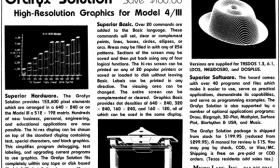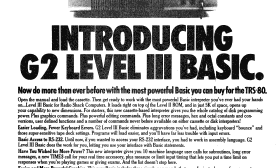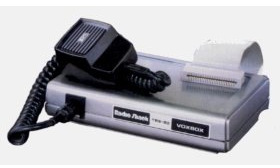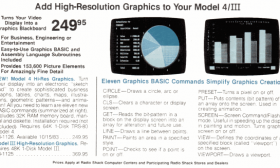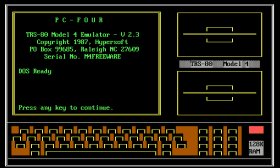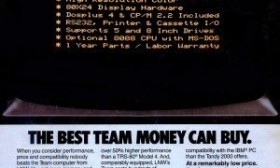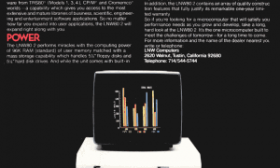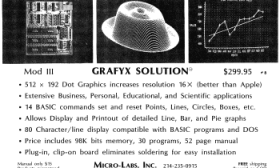The Model 4 Grafyx Solution was the most popular high-resolution add-on for the TRS-80 Model 4, and probably the most popular Model 4 add-on in general. It was introduced in 1984 for a price of $199.95 by Micro-Labs, creators of the earlier Model III Grafyx Solution. The Model 4 Grafyx Solution provided true high-resolution access to every pixel on the 640 by 240 Model 4 display, yet was easily user-installable in only a few minutes.
Unlike the Model III Grafyx Solution, which was memory mapped, the Model 4 Grafyx Solution was port-mapped. It used the same ports and mapping as the Radio Shack Model 4 high-resolution board. This meant that the Model 4 Grafyx Solution was almost completely compatible with the Radio Shack board and they could run the same programs. This had the odd side effect of making the Model 4 Grafyx Solution in Model III mode incompatible with the Model III Grafyx Solution.
The Model 4 Grafyx Solution had many advantages compared to the Radio Shack board:
(Read more...)
Level III BASIC was an enhanced version of Level II BASIC for the TRS-80 Model I. It was created by Microsoft, also the authors of Level II BASIC, but sold by GRT Corporation on cassette for $49.95. Level III BASIC was said to be the first consumer product from Microsoft, which had previously sold only to manufacturers.
Rather than sell Level III BASIC directly to consumers, Microsoft decided to release it through GRT Corporation in 1978. GRT Corporation, which stood for Great Records and Tapes, was a music company that had expanded into the software business. The GRT software division, named G2, was started by Vern Raburn and Level III BASIC was sold under the G2 label.
The Level III BASIC manual contains this surprising statement of authorship:
(Read more...)
The TRS-80 VOXBOX (catalog number 26-1181) was an early microcomputer speech-recognition product for the TRS-80 Model I. Introduced in July 1979 by Radio Shack for a price of $169.95, the VOXBOX was described as “electronic ears for your Model I.” The VOXBOX was only available for the Model I; there never was a version for the Model III.
Here is a description of the VOXBOX from a 1980 Radio Shack catalog, where it was paired with the $399 TRS-80 Voice Synthesizer:
(Read more...)
Radio Shack introduced the TRS-80 Microcomputer System, later known as the Model I, in August 1977. It was the first member of the original line of TRS-80 computers. Radio Shack followed the Model I with the mostly compatible Model III in 1980 and then the Model 4 in April 1983. But other than the transportable Model 4P in November 1983 and the improved Model 4D in 1985, there were no further members of this computer family.
Around the time of the development of the Model 4, Radio Shack engineers did plan a computer that could have followed it. Although not known by the name within Radio Shack, this often rumored computer was usually called the “Model 5” or the “Model 4C” by the public.
By considering all of the available bits of information, it is possible to piece together details about the key features of the “Model 5”:
(Read more...)
Radio Shack introduced their high-resolution add-on for the Model 4 (catalog number 26-1126) on October 15, 1983. Just like their Model III high-resolution board, it was never identified by name in any Radio Shack catalog. The official name seems to have been “TRS-80 Model 4 Computer Graphics” but it was usually referred to as the “Radio Shack Model 4 high-resolution board.”
At $249.95, the Model 4 high-resolution board was $80 cheaper than the Model III version. It provided a nearly identical hardware interface to the Model III version, with the same 640 by 240 resolution. It’s interesting to note that the Macintosh screen at the time was 576 by 340.
(Read more...)
PC-Four was the first TRS-80 Model 4 emulator for IBM PC compatible computers. It was written by Michael Gingell and introduced by Hypersoft in mid-1987 for a price of $79.95. PC-Four required a computer with at least 384K of memory and worked on both floppy and hard drive systems.
PC-Four (sometimes referred to as PC4) was quite different than later TRS-80 emulators. It achieved most of its compatibility not through Model 4 hardware emulation but by emulating the Model 4 operating system. This approach (similar to the MS-DOS emulator DOSBox today) allowed PC-Four to approximate Model 4 speed when running on a Tandy 1000 SX. The PC-Four manual described it this way:
(Read more...)
The LNW Team was an intriguing idea for a computer to bridge the TRS-80 and MS-DOS worlds. It was sold by LNW Computers, the company responsible for the LNW System Expansion, the LNW80, and the LNW80 Model 2.
The computer appears to have been the same externally as the LNW80 Model 2, although the standard memory was increased to 160K and the clock speed increased to 5.3 MHz. What really set the LNW Team apart was the optional 8088 board.
(Read more...)
One of the biggest weaknesses of the TRS-80 Model I was the lack of lowercase characters on the screen. Although that omission was hardly unique to the Model I (many computers at the time lacked lowercase, including the Apple II), it was still a notable limitation that affected many applications, especially word processing.
The two people most responsible for the Model I (originally known as the Radio Shack TRS-80 Microcomputer System) were Don French and Steve Leininger. Don French, described as “the originator of the TRS-80 project,” was a buyer for Radio Shack who had long pushed for Radio Shack to manufacture a microcomputer. Steve Leininger was the engineer who designed almost all of the hardware of the Model I and created the original Level I BASIC.
Steve Leininger mentioned lowercase in a talk he gave to the San Diego Computer Society in September 1977, just one month after the TRS-80 was introduced:
(Read more...)
The LNW80 Model 2, sometimes referred to as the LNW80/2, was a TRS-80 compatible computer sold by LNW Computers (formerly LNW Research Corporation). Introduced in late 1982 for a price of $2695, the LNW80 Model 2 was an upgrade to the original LNW80. The LNW80 Model 2 provided nearly complete compatibility with the TRS-80 Model I but added many new features and enhancements. In addition to being available through direct sales or through dealers in the United States, the LNW80 Model 2 was also sold in Australia and New Zealand through Micro-80 magazine.
Unlike the earlier LNW80, the LNW80 Model 2 was only sold as a complete computer, not as a “semi-kit.” It was enclosed in a very sturdy (and heavy) steel case which featured an enhanced keyboard. The keyboard had several extra keys not found on a TRS-80 Model I, including CONTROL, CAPS LOCK, and two function keys (F1 and F2). There were also dual reset keys (one on each side of the keyboard) that would reset the computer when pressed simultaneously.
(Read more...)
The Model III Grafyx Solution was a high-resolution graphics add-on for the TRS-80 Model III. Created by Ted Carter, president of Micro-Labs, the Grafyx Solution was introduced in early 1982 for a price of $299.95. There never was a Model I version of the Grafyx Solution.
The Model III Grafyx Solution used a different approach than 80-GRAFIX, an earlier Micro-Labs product for the Model I and III. While 80-GRAFIX could only simulate high-resolution graphics by redefining the character set, the Grafyx Solution provided full access to the 512 by 192 resolution of the Model III.
No soldering was required to install the Grafyx Solution. Instead, installation consisted of plugging the Grafyx Solution into the Model III and using special micro-clips to attach it to specific pins on chips already in the Model III.
(Read more...)
